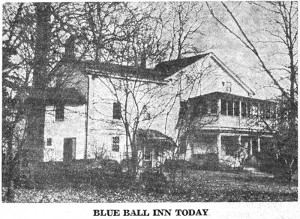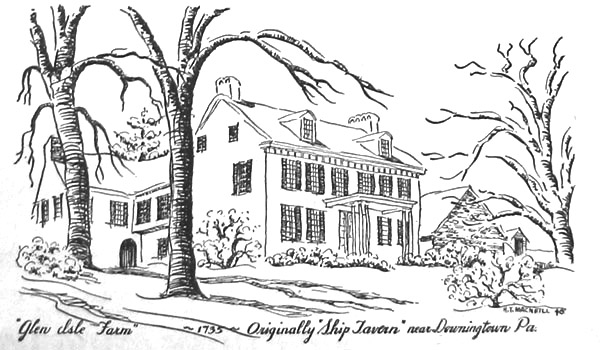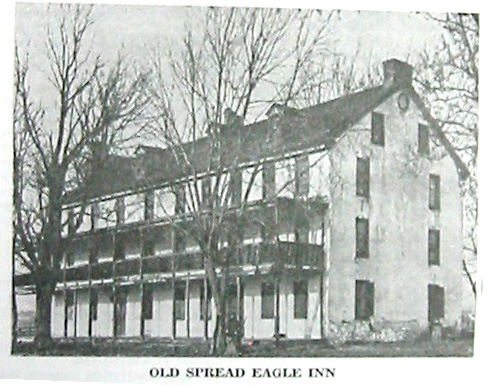Back of the present large front room of the old Blue Ball Inn in Daylesford which has recently been purchased by the Paul Warner family of Wayne, is the original Inn kitchen. Just as the life of the tavern in the late 1700’s and the early 1800’s centered in this room, so has family life centered there for the past fifty-odd years for the John Croasdale family and so will it center in the future years for the Warner family. For when the Croasdales acquired the Inn in 1894 the old kitchen was made into a “book room”. It is now undoubtedly the most interesting place in the old house.
This book room is down one step from “the commons room”, as the long front room, created by throwing into one the old taproom and the parlor, is called. The beaten earth floor of the first old kitchen has long since been covered by a wooden one. Three sides of the room, except where doors and windows interpose, are taken up by book shelves that go from floor to raftered ceiling. The south side is given over almost entirely to the wide deep fireplace, so large that one can literally “sit in the chimney corner”. Blackened by the smoke of two centuries, the huge fireplace still has in it the old hand-forged crane, and the “lazy boy” on which many kinds of food were baked. The oven which was originally there has since been bricked up, however.
Directly opposite each other in this room are two doors level with the ground outside. It is a matter of tradition that when this room was the kitchen for the old Inn the backlog for the cooking fire was dragged in at one door by a horse which was driven out the opposite door after the log had been rolled to the fireplace.
As the Warners sit around a blazing fire of a cold winter’s night with the light from their reading lamps making shadows in the corners of the room, it will be easy to imagine very different scenes of a century and a half ago. Then drivers of packhorse trains and Conestoga Wagons gathered around other blazing fires as they paused to eat and later to sleep during the tedious treks along the old Conestoga road.
Up in the rafters of this book-room is a small ladder which was originally made and used about sixty years when one of the early members of the Croasdale family wanted on occasion to make a quiet exit to sleeping quarters upstairs without disturbing guests in the front room. At that time there was a trap door in the floor of the room over the “book room” which was reached by means of this ladder. The main stairway, however, is a narrow boxed-in one leading from the living room. So worn are the trades from the footsteps of many generations that soon they will have to be replaced, interesting though they now are.
The narrow upstairs hallway leads into the front bedroom still as it was originally except for the door which leads onto the second floor porch, which was a later addition to the house. The charm of the room lies in its many windows and its original fireplace. Back of this is a tiny bedroom, while over the old kitchen is a larger room which will be used as a study when the Warners move in. Back of this is the “secret room” of the old house which is reached by a narrow and very inconspicuous passage way at the end of which is a door with a trick latch. One must learn the secret of this latch–and afterwards remember it–in order to enter this room at all. The reason for its one time secrecy is not clear nowadays. It is a plain little room once heated by a Franklin stove which has now gone its way. On the third floor are three bedrooms.
And since no story of an odd house is really complete without its ghost, so must the Blue Ball Inn have its ghost, perhaps even more than one! In the early 1800’s many sinister stories centered around it, all having to do with one Prissy Robinson, granddaughter of Bernhard Vauleer, one of the early owners of the Inn. According to these tales, peddlers who often carried goodly sums of money with them frequently stopped at the Inn to spend the night. Before the great fireplace in the old kitchen Prissy would serve them steaming suppers along with a glass of hot rum. When these same peddlers went up to the room over the kitchen they would find a keg of whiskey and a pannikin beside the bed. After partaking freely of the whiskey they would be in a sleep too deep to be roused by the stealthy figure that would creep in the door. A quick sharp blow – and another limp figure would be dragged down the narrow stairs, to be hidden until a shallow grave could be dug in the beaten earth floor of the kitchen or in the orchard!
Still another tale concerns a woman guest at the Blue Ball who recklessly displayed a large quantity of money at supper in the old kitchen. Next morning her body was found hanging from the wall that still encloses the boxed stairway. her death was called suicide. However, so many doubted the truth of this that the suspicions of the entire countryside were aroused. And as a consequence many would no longer venture into the Blue Ball Inn after dark!
After Prissy Robinson’s death in 1860 less credence was put in these harrowing stories. Many who know her regarded her as a sharp tongued old scold who probably did no one any actual harm. And then after the Croasdales bought the Blue Ball all the harrowing stories were revived. For in making excavations for certain improvements six human skeletons were found under the cellar floor. “These human structures were complete”, according to an article in the Philadelphia “North American”, although some showed broken bones or cleft skulls . . . It is certainly an interesting question how many persons were done away with at the Inn during the years from 1809 to 1860.”
At any rate, so the story goes, the ghost of Prissy Robinson, once roused from her long sleep by the workmen’s picks scraping the skeletons of those she had buried, was seen flitting around the house and grounds. Strange sounds have been heard and bureau drawers have been seen to open of their own volition–or so it is said. At any rate Prissy is supposedly looking in these drawers for clean garments to replace her own blood-stained ones!
But in the words of Joseph L. Copeland, a Paoli reporter writing the story of the Blue Ball Inn for “House Beautiful” in May, 1929, this columnist would say, “In spite, or possibly because of its ghost, it is a friendly old house sitting there by the roadside in the sun. In front of its door America has passed in historic procession–pack horse trains, oxcarts, Conestoga wagons, pushing always into the West, within its low-heeled rooms have paused those men of whom the poet sang:–
‘Conquering, holding, daring,
venturing as we go to the urn-
known ways,
Pioneers! O Pioneers'”



